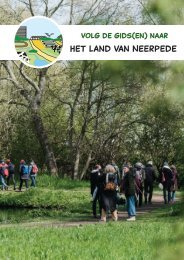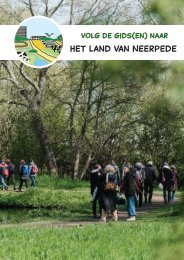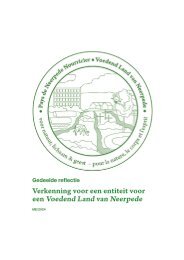Water as Leverage - Wadden Sea Region
- No tags were found...
You also want an ePaper? Increase the reach of your titles
YUMPU automatically turns print PDFs into web optimized ePapers that Google loves.
<strong>Water</strong> <strong>as</strong> <strong>Leverage</strong> for Climate Adaptation: <strong>Wadden</strong> <strong>Sea</strong> <strong>Region</strong><br />
Esbjerg<br />
Challenges<br />
<strong>Water</strong> District in E<strong>as</strong>t<br />
Esbjerg<br />
WITH WET FEET IN THE GROUND<br />
The e<strong>as</strong>tern neighbourhood of<br />
Esbjerg is facing different water<br />
issues, due to various re<strong>as</strong>ons.<br />
Firstly, the neighbourhood w<strong>as</strong> a<br />
former wetland area, but the stream<br />
h<strong>as</strong> been covered up, and housing<br />
h<strong>as</strong> been built on the wetlands<br />
surrounding this stream. The exact<br />
course of the stream is nowadays<br />
largely unknown but can be traced<br />
back in the natural topography. It<br />
is clear that the draining function<br />
of the stream for the bigger water<br />
catchment area is gone. The other<br />
water catchment area in the e<strong>as</strong>t<br />
currently h<strong>as</strong> a river that can still flow<br />
into the sea — however, the current<br />
port expansion could compromise<br />
the discharge of this river in the<br />
future.<br />
Secondly, the soil consists of an<br />
impermeable clay layer, creating a<br />
high groundwater table and limited<br />
percolating capacity. This forms an<br />
issue for the neighbourhood: some<br />
buildings have to pump up to 70.000<br />
litres of ground water per year out of<br />
the b<strong>as</strong>ement.<br />
Thirdly, the port is a very hardened<br />
surface and doesn’t allow any water,<br />
both ground and surface water, to<br />
percolate or flow into the sea. The<br />
port is literally a ‘bath plug’ for the<br />
water catchment area of this e<strong>as</strong>tern<br />
neighbourhood.<br />
The combination of the lost stream,<br />
the built-up wetlands, the high<br />
groundwater table, the impermeable<br />
soils and the considerable amount<br />
of hardened surfaces, especially in<br />
the port area, leads to flooding in a<br />
big part of the neighbourhood when<br />
heavy rains occur. This pluvial flood<br />
calls for a re-design of this area of<br />
Esbjerg and its water system in order<br />
to prevent flooding damage.<br />
A MIXED NEIGHBOURHOOD WITH<br />
SPECIFIC SOCIAL CHALLENGES<br />
The e<strong>as</strong>tern neighbourhood consists<br />
of a variety of housing typologies<br />
and living conditions, which pose<br />
different challenges. Historically,<br />
this area of the city consisted<br />
of allotment gardens with small<br />
summer houses on the inexpensive<br />
grounds of riverbanks and wetlands.<br />
Then gradually, from the station<br />
towards the e<strong>as</strong>t, more freestanding<br />
vill<strong>as</strong> were built on these low-priced<br />
plots. This makes the district a very<br />
mixed area that evolved differently<br />
over the l<strong>as</strong>t decades.<br />
Firstly, the utmost e<strong>as</strong>tern part of the<br />
neighbourhood shifted from being<br />
a very attractive neighbourhood<br />
towards a roughened and neglected<br />
area. It struggles with a negative<br />
identity: it is seen <strong>as</strong> a low-income<br />
part of the city and with historical<br />
issues (what issues?). It is telling<br />
that the social housing area (name?)<br />
is currently on the observe list of<br />
ghetto districts* and the northe<strong>as</strong>tern<br />
housing area ‘Stengårdsvej’, just<br />
outside the inner ring road of<br />
10<br />
Esbjerg


















